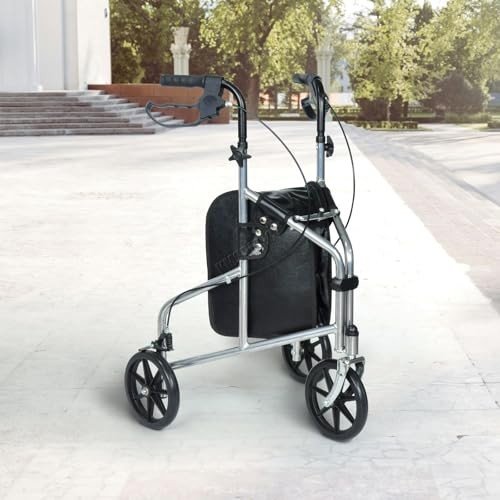See What Rollator For Walking Tricks The Celebs Are Using
Understanding Rollators for Walking: A Comprehensive Guide
Rollators are an important mobility aid that enhances the flexibility and self-reliance of those with restricted walking abilities. They are developed not just to use stability and support however likewise to encourage mobility and engagement in day-to-day activities for people of all ages. This short article delves deep into the world of rollators, offering insights into their features, benefits, types, maintenance, and key factors to consider when choosing the most appropriate model.

What is a Rollator?
A rollator is a mobile walking aid geared up with four wheels, handgrips, a seat, and often comes with extra features such as storage baskets and brakes. Unlike conventional walkers, which need the user to raise them off the ground, rollators can be pressed along as the user walks, making them particularly helpful for people with minimal strength or balance.
Key Features of Rollators
Rollators include numerous functions that improve their use:
- Wheels: Most rollators feature swivel or fixed wheels for much better maneuverability indoors and outdoors.
- Brakes: Hand brakes permit users to control their speed and stop safely.
- Seat: Many rollators offer an integrated seat for users to rest when required.
- Lightweight Frame: Constructed from lightweight materials, rollators are simple to raise and transfer.
- Adjustable Height: Most rollators permit height adjustments to accommodate the user’s stature.
Benefits of Using a Rollator
Utilizing a rollator for walking provides numerous benefits, especially for seniors and individuals with mobility difficulties. These may consist of:
- Improved Stability: Rollators supply a steady base that helps avoid falls.
- Increased Mobility: Users can move about more freely, whether indoors or outdoors.
- Boosted Independence: With a rollator, users can perform everyday jobs without requiring help.
- Hassle-free Seating: The accessibility of a seat allows users to rest whenever they feel fatigued.
Types of Rollators
When considering which rollator to pick, it’s essential to acknowledge the numerous types offered. The main classifications consist of:
- Standard Rollators: Typically have 4 wheels and a seat, ideal for most indoor and outdoor environments.
- Durable Rollators: Designed for bigger individuals, these rollators have reinforced frames and higher weight capacities.
- Three-Wheel Rollators: These provide a more lightweight and compact alternative, making them perfect for narrower areas.
- Foldable Rollators: Convenient for transportation, these designs can be easily collapsed and stored when not in use.
| Kind of Rollator | Description | Best For |
|---|---|---|
| Standard Rollator | 4 wheels, seat, lots of options. | General use, indoor and outdoor. |
| Heavy-Duty Rollator | Enhanced for higher weight capacity. | Larger individuals requiring additional support. |
| Three-Wheel Rollator | Compact and lightweight, simple to maneuver. | Restricted area and indoor use. |
| Foldable Rollator | Collapsible for simple transport. | Frequent travelers or caretakers. |
How to Choose the Right Rollator
Picking the right rollator includes thinking about several elements to satisfy the individual’s particular requirements:
- Weight Capacity: Ensure the rollator can support the user’s weight.
- Height Adjustability: Look for models that can be changed to the user’s height for optimal comfort.
- Features Needed: Consider whether additional functions like baskets, trays, or hand brakes are essential.
- Meant Use: Determine if the rollator will be mostly used indoors, outdoors, or both.
Maintenance Tips for Rollators
To lengthen the life expectancy and performance of a rollator, routine maintenance is vital. Here are some helpful ideas:
- Check Brakes: Regularly test brakes to guarantee they engage correctly.
- Inspect Wheels: Look for signs of wear and tear; wheels should roll efficiently.
- Tidy Regularly: Wipe down the frame and elements to avoid dirt accumulation.
- Tighten up Bolts: Periodically check and tighten up any loose bolts or screws.
Frequently Asked Questions (FAQs)
1. Can rollators be used on irregular surfaces?
Yes, many rollators are developed with bigger wheels or specialized treads to deal with irregular surface areas. Nevertheless, users need to exercise caution and guarantee they feel steady when navigating such terrains.
2. How do I determine the right height for a rollator?
When standing straight, the handles of the rollator should align with the user’s wrist when their arms are unwinded at their sides. This position guarantees comfortable use.
3. Do I require a prescription to purchase a rollator?
No, rollators can be acquired without a prescription. However, speaking with a healthcare expert can be helpful to recognize the best option based upon private requirements.
4. Are rollators covered by insurance coverage?
Protection for rollators can vary based on the type of insurance strategy. Numerous Medicare strategies provide protection for some kinds of walkers, including rollators. It’s recommended to contact the insurance company straight.
Rollators for walking considerably boost the lives of numerous people dealing with mobility difficulties. Supplying stability, self-reliance, and ease of motion, they function as important tools for maintaining an active lifestyle. Comprehending the different types, functions, and how to keep them in good condition can empower users in making informed choices. As mobility requirements differ considerably from individual to individual, it is important to choose a rollator that best fulfills private requirements and improves lifestyle.

